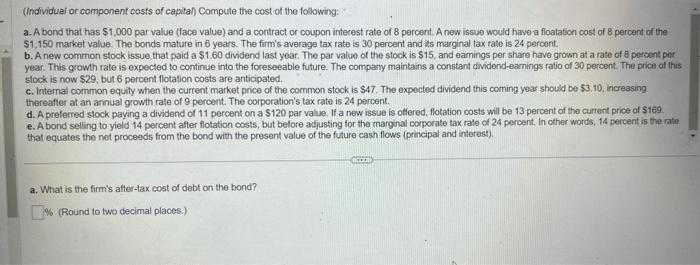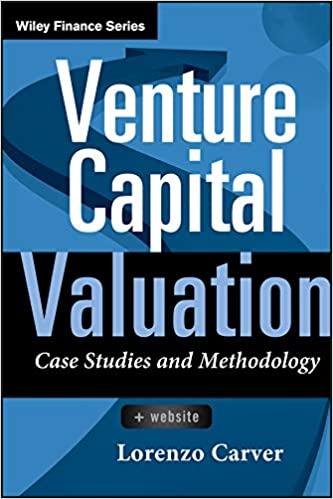Answered step by step
Verified Expert Solution
Question
1 Approved Answer
I NEED HELP WITH QUEATIONS A-E A- A bond that has $1,000 par value (face value) and a contract or coupon interest rate of 8
I NEED HELP WITH QUEATIONS A-E
(individual or component cosis of capital) Compute the cost of the following: a. A bond that has $1,000 par value (face value) and a contract or coupon interest rate of 8 percent. A new issue would have a floalation cost of 8 percent of the $1,150 market value. The bonds mature in 6 years. The firm's average tax rate is 30 percent and its marginal tax rate is 24 percent. b. A new common stock issue that paid a $1.60 dividend last year. The par value of the stock is $15, and eamings per share have grown at a rate of 8 percent per year. This growth rate is expected to continue into the foreseeable future. The company maintains a constant dividend-eamings ratio of 30 percent. The price of this stock is now $29, but 6 percent flotation costs are anticipated. c. Internal common equity when the current market price of the common stock is $47. The expected dividend this coming year should be $3.10, increasing thereafter at an annual growth rale of 9 percent. The corporation's tax rate is 24 percent. d. A preferred stock paying a dividend of 11 percent on a $120 par value. If a new issue is otfered, flotation costs will be 13 percent of the current price of $169. e. A bond selling to yield 14 percent after flotation costs, but before adjusting for the marginal corporate tax rate of 24 percent. In other words, 14 percent is the rate that equates the net proceeds from the bond with the present value of the future cash flows (principal and interest). a. What is the firm's after-tax cost of debt on the bond? 6 (Round to two decimal places.) A- A bond that has $1,000 par value (face value) and a contract or coupon interest rate of 8 percent. A new issue would have a floatation cost of 8 percent of the $1,150 market value. The bonds mature in 6 years. The firm's average tax rate is 30 percent and its marginal tax rate is 24 percent. 
B- A new common stock issue that paid a $1.60 dividend last year. The par value of the stock is $15, and earnings per share have grown at a rate of 8 percent per year. This growth rate is expected to continue into the foreseeable future. The company maintains a constant dividend-earnings ratio of 30 percent. The price of this stock is now $29, but 6 percent flotation costs are anticipated. C- Internal common equity when the current market price of the common stock is $47. The expected dividend this coming year should be $3.10, increasing thereafter at an annual growth rate of 9 percent. The corporation's tax rate is 24 percent.
D- A preferred stock paying a dividend of 11 percent on a $120 par value. If a new issue is offered, flotation costs will be 13 percent of the current price of $169.
E- A bond selling to yield 14 percent after flotation costs, but before adjusting for the marginal corporate tax rate of 24 percent. In other words, 14 percent is the rate that equates the net proceeds from the bond with the present value of the future cash flows (principal and interest).

Step by Step Solution
There are 3 Steps involved in it
Step: 1

Get Instant Access to Expert-Tailored Solutions
See step-by-step solutions with expert insights and AI powered tools for academic success
Step: 2

Step: 3

Ace Your Homework with AI
Get the answers you need in no time with our AI-driven, step-by-step assistance
Get Started


